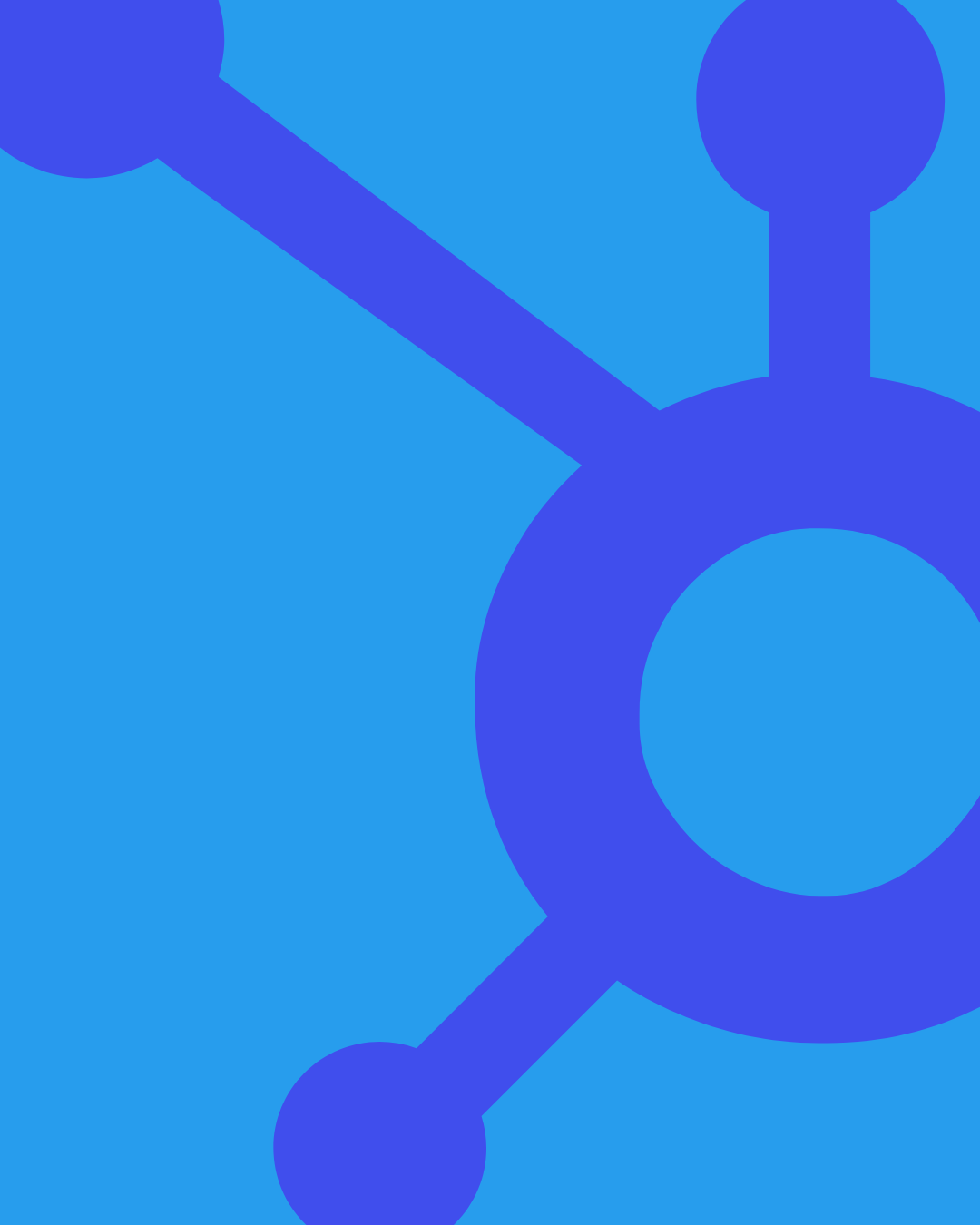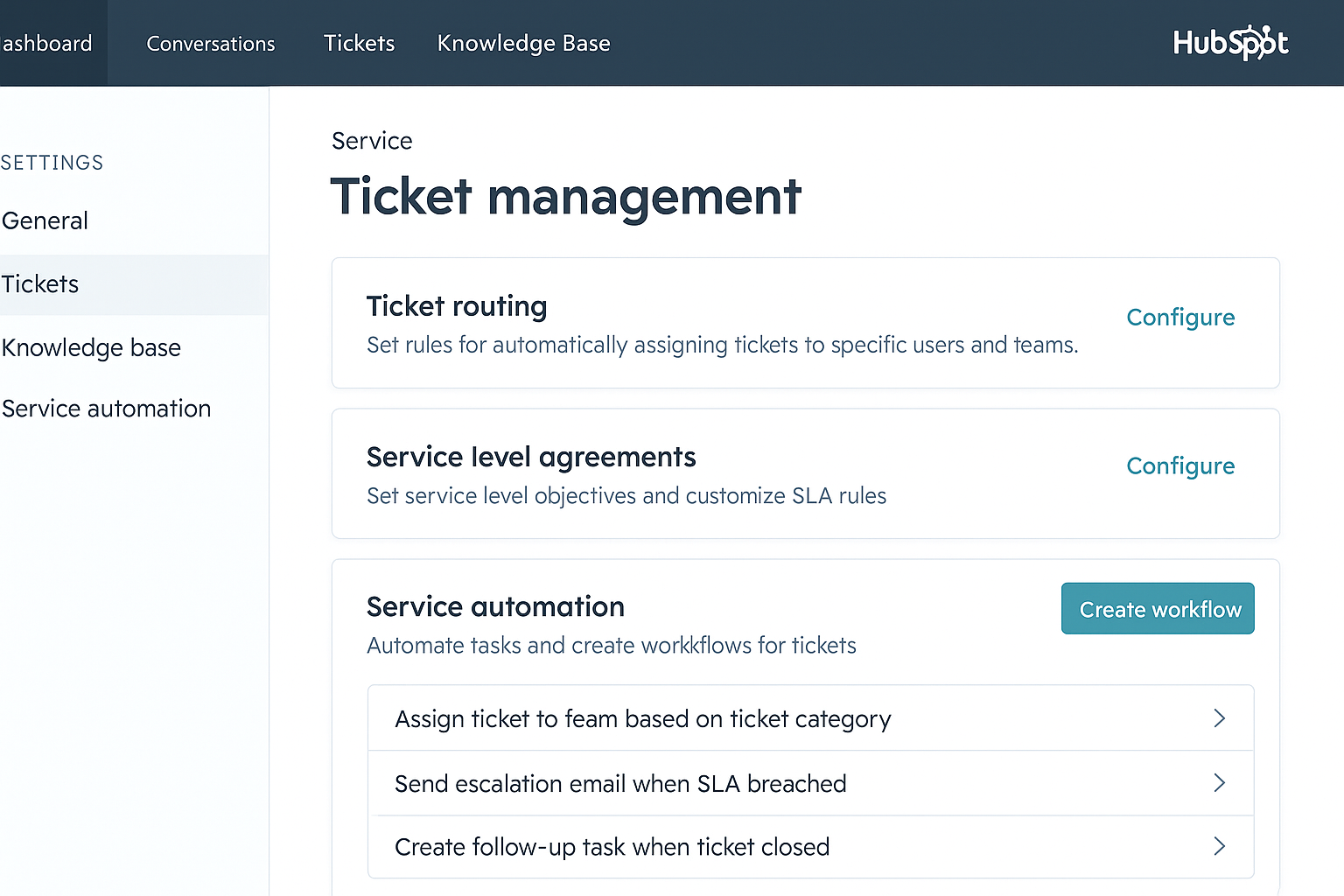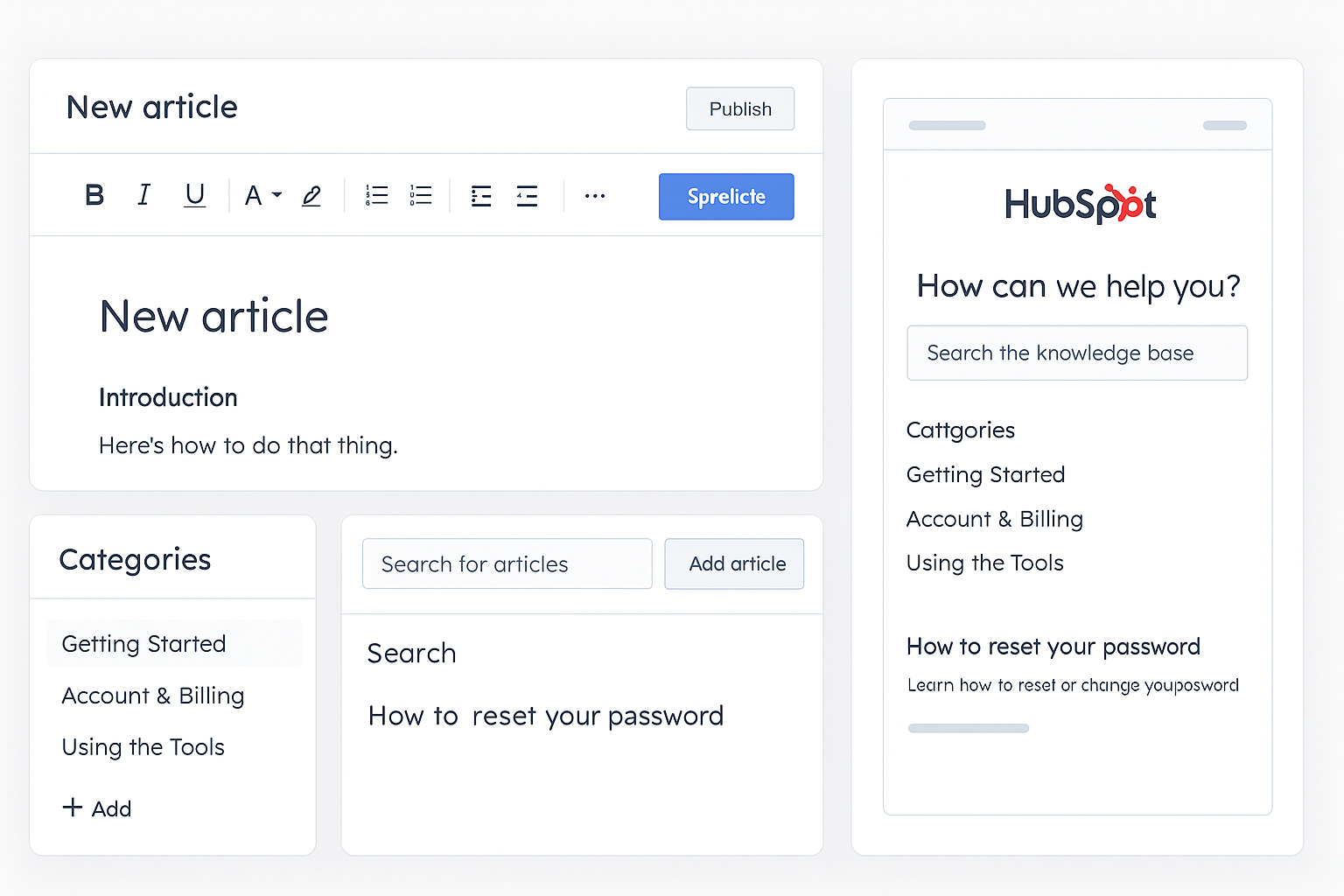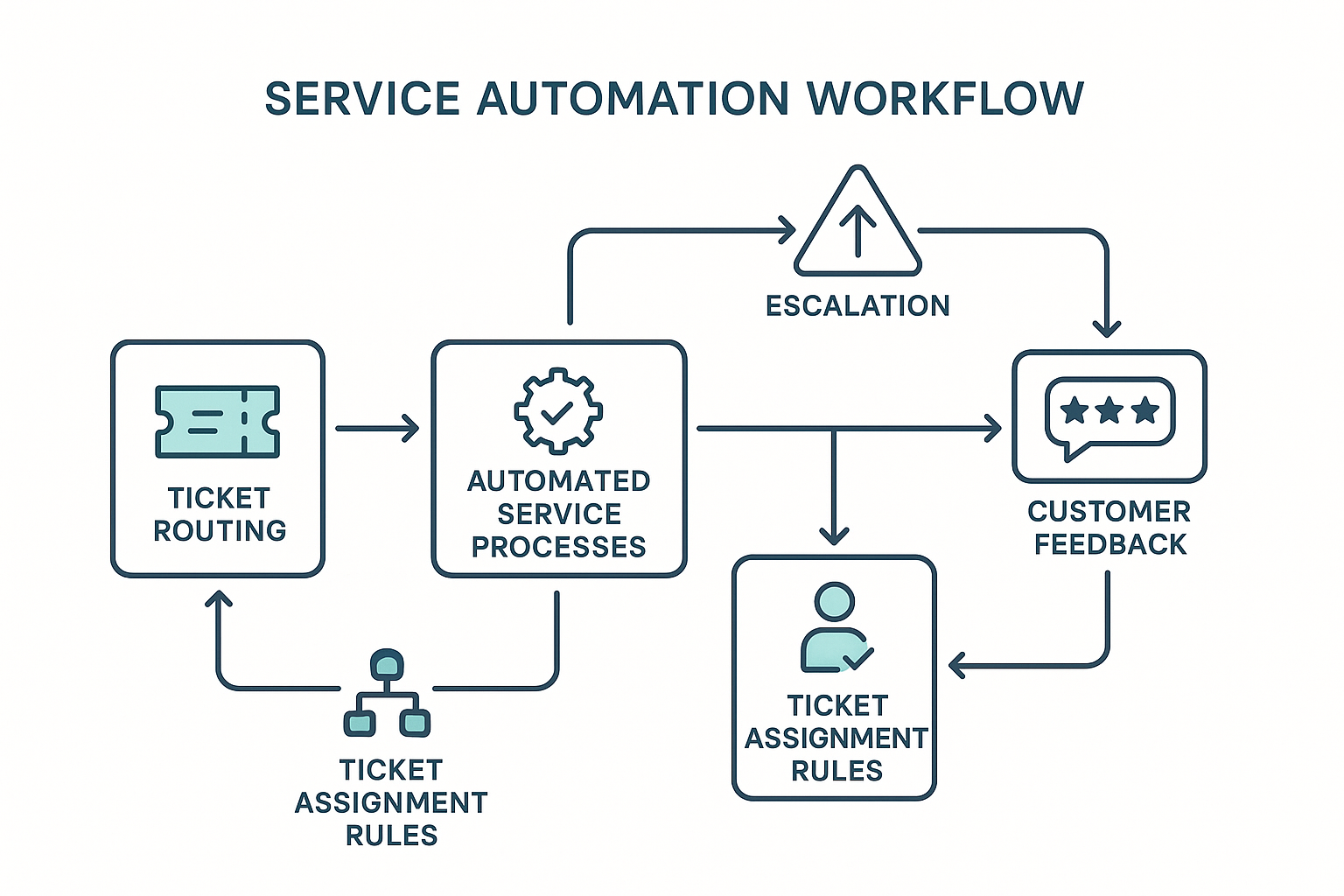HubSpot Service Hub Implementation: Building Better Customer Support


Introduction: Transforming Customer Support Through Strategic Service Hub Implementation
In the competitive business landscape of 2025, exceptional customer service has evolved from a nice-to-have differentiator into a fundamental requirement for sustainable business growth and customer retention. Modern customers expect immediate, personalized, and seamless support experiences across multiple channels, while businesses struggle to deliver consistent service quality at scale without overwhelming their support teams or compromising operational efficiency. The challenge lies not just in responding to customer inquiries, but in creating comprehensive support ecosystems that anticipate customer needs, provide proactive assistance, and continuously improve service delivery through data-driven insights and optimization.
HubSpot Service Hub emerges as a comprehensive customer service platform implementation solution designed to address these complex challenges while providing customer support teams with the integrated tools, automation capabilities, and analytical insights necessary to excel in contemporary service environments. However, the transformative potential of Service Hub can only be realized through strategic implementation that aligns with your organization's specific customer service objectives, support team structure, and operational workflows. Many customer support teams struggle with platform adoption because their systems are poorly configured, lack proper customization, or fail to integrate seamlessly with existing processes and customer relationship management strategies.
The difference between successful and failed customer service platform implementations often lies not in the sophistication of the technology itself, but in the thoroughness and strategic thinking applied during the initial Service Hub setup and configuration phase. Modern customer service platform implementation extends far beyond basic installation to encompass strategic planning, process design, and change management considerations that determine long-term success and customer satisfaction improvement. Support teams must simultaneously manage ticket management system setup, knowledge base creation, customer feedback management, and service performance metrics while maintaining service quality and team productivity during the transition period.
This comprehensive implementation challenge explains why 82% of customer support teams report that proper help desk software configuration significantly improves their response times and customer satisfaction scores [1]. The implementation process we'll explore in this guide goes beyond basic installation to encompass strategic planning, workflow design, and optimization considerations that transform Service Hub from a simple ticketing tool into a powerful customer experience enhancement platform that drives loyalty, retention, and business growth.
This guide provides customer support teams with a detailed roadmap for implementing HubSpot Service Hub effectively, covering everything from initial planning and account setup through advanced automation workflows and comprehensive performance analytics. Whether you're implementing Service Hub for the first time or optimizing an existing deployment, this guide ensures that your investment delivers maximum value through proper configuration, user adoption, and ongoing optimization that supports your organization's customer service excellence objectives.
Pre-Implementation Planning and Strategic Foundation
Successful HubSpot Service Hub implementation begins with comprehensive strategic planning that aligns technology capabilities with customer service objectives, support team structure, and organizational processes. This foundational planning phase determines whether your customer service platform becomes a powerful customer satisfaction engine or an underutilized expense that creates complexity without delivering meaningful business value. The planning process involves assessing current support processes, defining clear service objectives, and establishing the organizational framework necessary for successful adoption and long-term optimization.

Comprehensive Service Process Assessment and Analysis
The foundation of effective Service Hub implementation lies in thoroughly understanding your current customer support processes, identifying areas for improvement, and mapping these insights to HubSpot's extensive customer service capabilities. This assessment should examine every aspect of your support operation, from initial customer contact and ticket creation through resolution workflows and customer satisfaction measurement. Many teams make the critical mistake of rushing into platform implementation without fully understanding their existing processes, leading to systems that don't align with actual workflows and fail to support user productivity or customer satisfaction improvement.
Begin by documenting your current customer support process in comprehensive detail, including every touchpoint, escalation path, and handoff between team members or departments. This documentation should capture not just the official process as defined in training materials or standard operating procedures, but the actual workflows that support team members follow in practice. Often, there are significant differences between documented and actual processes, and understanding these variations is crucial for designing a customer service platform that supports real-world usage patterns while improving efficiency and customer experience quality.
The assessment should also identify pain points, inefficiencies, and gaps in your current approach that Service Hub can address through automation, integration, or enhanced analytics capabilities. Common issues include inconsistent ticket routing processes, manual escalation workflows that don't scale effectively, lack of visibility into customer interaction history across channels, and inadequate integration between support and sales activities.
By clearly identifying these challenges upfront, you can ensure that your Service Hub implementation specifically addresses your most pressing needs rather than simply replicating existing processes in digital form.
Customer data quality and organization represent another critical assessment area, as the effectiveness of any customer service platform depends heavily on the quality and structure of customer information it contains. Examine your current customer and interaction data to identify inconsistencies, duplicates, missing information, and organizational challenges that must be addressed before migration and configuration. Poor data quality can undermine even the most sophisticated customer service automation configuration, making this assessment essential for long-term success and customer satisfaction improvement.
Strategic Objective Definition and Success Metrics Establishment
Effective Service Hub implementation requires clear, measurable objectives that guide configuration decisions and provide benchmarks for evaluating success and return on investment. These objectives should align with broader business goals while addressing specific customer support team challenges identified during your process assessment. Without clear objectives, customer service platform implementations often become unfocused efforts that fail to deliver meaningful business impact or justify the investment in technology and resources.
Customer service platform implementation objectives might include reducing average response times, improving first-contact resolution rates, or increasing customer satisfaction scores through better support experiences and more efficient problem resolution. Help desk software configuration goals could focus on improving ticket routing accuracy, reducing escalation times, or enabling more sophisticated customer interaction tracking that provides comprehensive service history visibility.
Support team workflow optimization objectives often center on improving agent productivity, enhancing collaboration capabilities, or enabling more accurate performance measurement and coaching opportunities.
Success metrics should be specific, measurable, and tied directly to customer satisfaction outcomes rather than system usage statistics or operational metrics alone. While user adoption rates and ticket volume metrics are important operational indicators, the ultimate measure of customer service platform success lies in improved customer satisfaction scores, enhanced resolution rates, and increased customer retention that can be directly attributed to support activities. Establishing baseline measurements for key performance indicators enables accurate assessment of Service Hub's impact over time while providing data for ongoing optimization efforts.
Timeline expectations must be realistic and account for the learning curve associated with new platform adoption and the iterative nature of customer service automation optimization. Most support teams require 30-60 days to become proficient with new customer service platforms, with full optimization often taking 3-6 months as workflows are refined, knowledge bases are developed, and advanced features are gradually implemented. Setting appropriate expectations helps maintain organizational support during the inevitable challenges of system transition while ensuring adequate resources are allocated for proper implementation and optimization.
Team Role Definition and Workflow Planning
Service Hub's effectiveness depends heavily on proper team role definition and workflow planning that balances individual responsibilities with collaborative requirements and customer service objectives. This planning should consider not just current team structure and capabilities, but anticipated growth, skill development needs, and organizational changes that might affect workflow requirements over time. Poor workflow planning often leads to either overly complex systems that frustrate users or overly simplified configurations that fail to support sophisticated customer service strategies.
Front-line support roles typically require access to ticket management tools, customer interaction history, and knowledge base resources, with the ability to create, update, and resolve customer issues while maintaining service quality and response time standards. Front-line agents need workflow tools that support efficient customer interaction, quick access to relevant information, and seamless escalation processes when issues require specialized expertise or management intervention.
Specialized support roles require broader access to advanced troubleshooting tools, customer account management capabilities, and escalation workflows that support complex problem resolution and customer relationship management. Specialized agents need visibility into customer history, product usage patterns, and previous interaction outcomes that enable effective problem diagnosis and resolution. These roles often serve as the bridge between front-line support and technical or management teams, requiring tools that support both customer interaction and internal collaboration.
Management and supervisory roles must have comprehensive access to performance analytics, team productivity metrics, and customer satisfaction data that support strategic decision making and team development activities. Management roles need visibility into individual and team performance, customer satisfaction trends, and operational efficiency metrics that enable data-driven coaching and resource allocation decisions.
These roles frequently serve as the voice of customer feedback within support organizations, requiring tools that can translate customer interaction data into actionable insights and strategic recommendations.
Administrative roles must be carefully defined to ensure proper system maintenance while preventing unauthorized changes that could disrupt customer service operations or compromise data integrity.
Consider establishing multiple administrative levels, with basic administrators handling routine tasks like user management and knowledge base updates, while senior administrators manage system configuration, integration settings, and advanced automation workflows that require deep platform expertise and understanding of customer service best practices.
Core Service Hub Configuration and Foundation Setup
The initial configuration of your HubSpot Service Hub account establishes the fundamental infrastructure that will support all future customer service activities, ticket management processes, and performance analysis. This foundational setup encompasses user management, service configuration, and core system settings that must be carefully planned and implemented to ensure scalability, consistency, and effectiveness. Proper initial configuration prevents the need for disruptive changes later while establishing best practices that support long-term success and customer satisfaction improvement.

Account Setup and User Management Configuration
User configuration represents one of the most critical aspects of Service Hub setup, as improper user management can create security vulnerabilities, workflow inefficiencies, and collaboration challenges that persist throughout the platform's lifecycle. The user setup process should reflect your customer support organization structure while providing appropriate access levels that balance functionality with security, data integrity, and workflow efficiency requirements.
Begin by creating user accounts for all team members who will interact with Service Hub, ensuring that each user has appropriate contact information, role assignments, and initial access permissions that align with their responsibilities and skill levels. User creation should follow consistent naming conventions and organizational structures that make user management scalable as your support team grows and evolves. Consider establishing user groups or teams that reflect your support organization structure, enabling easier permission management, reporting segmentation, and workflow coordination.
Permission configuration requires careful consideration of each user's responsibilities, access needs, and security requirements within the context of your customer service operations and organizational policies. Front-line support agents typically need access to ticket management tools, customer interaction history, and knowledge base resources, with the ability to create, update, and resolve customer issues while maintaining appropriate data security and privacy protections. However, they may not need access to sensitive customer account information, administrative settings, or advanced analytics unless their roles specifically require such capabilities.
Specialized support agents require broader access to advanced troubleshooting tools, customer account management capabilities, and escalation workflows that support complex problem resolution and customer relationship management. This includes access to detailed customer history, product usage analytics, and integration data that enables comprehensive problem diagnosis and resolution. Specialist permissions should enable effective customer service delivery and collaboration without creating administrative burden or compromising system security and data integrity.
Administrative users need comprehensive system access to manage configurations, integration settings, user permissions, and data quality maintenance activities. However, administrative access should be limited to users who require such capabilities for their roles and have demonstrated the technical expertise necessary to manage complex system configurations. Excessive administrative permissions can create security risks and increase the likelihood of accidental configuration changes that disrupt customer service operations or compromise service quality.
Service Level Agreement Configuration and Management
Service Level Agreement (SLA) configuration establishes the performance standards and response time commitments that guide customer service operations while providing accountability frameworks for team performance and customer expectation management. This configuration must balance ambitious service goals with realistic operational capabilities, ensuring that SLA commitments enhance rather than compromise service quality and team productivity.
Response time SLA configuration should reflect your customer service commitments while considering factors like ticket complexity, customer priority levels, and team capacity that affect realistic response capabilities. SLA configuration should include different response time standards for different types of issues, customer segments, or priority levels that enable appropriate resource allocation while maintaining consistent service quality. Response time standards should be based on historical performance data and industry benchmarks rather than arbitrary targets that might be unrealistic or counterproductive.
Resolution time SLA configuration establishes expectations for issue resolution while accounting for the complexity and resource requirements of different problem types. Resolution SLAs should consider factors like technical complexity, required approvals or escalations, and integration with other business processes that might affect resolution timelines. Resolution standards should balance customer expectations with operational realities while providing clear guidelines for escalation and resource allocation decisions.
Priority-based SLA configuration enables differentiated service levels based on customer importance, issue severity, or business impact considerations. Priority configuration should reflect your customer segmentation strategy while ensuring that all customers receive appropriate attention and service quality. Priority-based SLAs should include clear criteria for priority assignment and escalation procedures that ensure high-priority issues receive appropriate attention without compromising service quality for other customers.
SLA monitoring and alerting configuration ensures that performance standards are consistently met while providing early warning systems for potential SLA breaches that require intervention or resource reallocation. Monitoring systems should provide real-time visibility into SLA performance while generating alerts that enable proactive management and problem prevention. SLA reporting should support both operational management and strategic analysis while providing data for continuous improvement and optimization efforts.
Ticket Management System Setup and Routing Configuration
Ticket management configuration establishes the systematic framework for capturing, organizing, and tracking customer issues throughout the resolution process. This configuration must balance comprehensive information capture with user efficiency, ensuring that ticket creation and management processes support both customer service quality and team productivity objectives.
Ticket creation configuration should streamline the process of capturing customer issues while ensuring that essential information is collected consistently and accurately. This includes defining required fields, optional information categories, and automated data population that reduces manual entry while maintaining data quality and completeness. Ticket creation should be intuitive for both customers and support agents while providing the information necessary for effective problem diagnosis and resolution.
Ticket categorization and tagging systems enable systematic organization and analysis of customer issues while supporting routing, reporting, and trend analysis activities. Categorization should reflect your product or service structure while providing meaningful insights into customer needs and problem patterns. Tag systems should support both operational workflow management and strategic analysis while remaining simple enough for consistent use by support team members.
Automated ticket routing configuration ensures that customer issues are directed to appropriate team members based on expertise, availability, and workload considerations. Routing rules should consider factors like issue type, customer priority, agent specialization, and current workload distribution that optimize both response times and resolution quality. Routing automation should include escalation procedures and overflow management that ensure no customer issues are overlooked or delayed due to capacity constraints.
Ticket status and workflow configuration establishes clear progression paths for customer issues while providing visibility into resolution progress and team performance. Status configuration should reflect your actual resolution processes while providing meaningful information to both customers and support team members about issue progression and expected timelines. Workflow configuration should support collaboration, escalation, and quality assurance processes while maintaining simplicity and user adoption.
Integration and Data Synchronization Setup
Integration configuration ensures seamless data flow between Service Hub and other business systems, maintaining information consistency while reducing manual data entry and the errors that can result from disconnected systems. Effective integration should support operational efficiency while preserving data quality, system reliability, and workflow continuity across your customer service technology stack.
CRM integration represents the most critical connection for most customer service organizations, ensuring that customer information, interaction history, and service data are properly synchronized between support and sales systems. This integration should provide support teams with comprehensive customer context while enabling sales teams to understand service history and customer satisfaction levels. CRM integration configuration should support customer lifecycle management, cross-selling opportunities, and comprehensive customer experience tracking that demonstrates the business value of customer service activities.
Knowledge management integration enables sophisticated self-service capabilities while maintaining content consistency and accuracy across customer touchpoints. This integration should support content creation, update workflows, and usage analytics that optimize knowledge base effectiveness while reducing support ticket volume. Knowledge integration should also consider content approval processes, version control, and access management that ensure information accuracy and consistency.
Communication platform integration provides comprehensive customer interaction capabilities while maintaining conversation history and context preservation across multiple channels. This integration should support email, chat, phone, and social media interactions while providing unified customer views that enable consistent service delivery regardless of communication channel. Communication integration should also consider compliance requirements, data retention policies, and privacy protections that affect customer interaction management.
Analytics platform integration provides comprehensive visibility into customer service performance across systems while enabling attribution modeling and ROI analysis that supports strategic decision making. This integration should connect Service Hub data with business intelligence systems, customer satisfaction surveys, and other performance data sources to provide holistic views of customer service effectiveness and business impact. Analytics integration should support both operational reporting and strategic analysis while maintaining data accuracy and consistency across platforms.
Knowledge Base and Self-Service Portal Development
Knowledge base creation and self-service portal development represent critical components of comprehensive Service Hub implementation that enable customers to find answers independently while reducing support ticket volume and improving overall customer experience. Effective knowledge management requires strategic content planning, intuitive organization, and ongoing maintenance that ensures information remains current, accurate, and easily accessible. The goal is to create self-service resources that anticipate customer needs while providing comprehensive support for common issues and questions.

Strategic Content Planning and Information Architecture
Knowledge base development begins with comprehensive analysis of customer questions, support ticket patterns, and information needs that inform content strategy and organizational structure. This analysis should examine both current support interactions and anticipated customer needs based on product development, market changes, and business growth that might affect information requirements. Effective content planning ensures that knowledge base resources address real customer needs rather than theoretical information that might not provide practical value.
Content audit and gap analysis should examine existing documentation, support materials, and frequently asked questions to identify information that can be repurposed for knowledge base use while highlighting gaps that require new content development. This audit should consider content quality, accuracy, and relevance while identifying outdated information that might confuse or mislead customers. Gap analysis should prioritize content development based on customer impact, support ticket volume, and business objectives that maximize knowledge base value and effectiveness.
Information architecture design establishes the organizational framework that enables customers to find relevant information quickly and intuitively. This architecture should reflect customer mental models and search patterns rather than internal organizational structures that might not align with customer expectations. Information organization should consider both browsing and search behaviors while providing multiple pathways to relevant content that accommodate different customer preferences and information-seeking strategies.
Content categorization and tagging systems enable sophisticated content organization and discovery while supporting analytics and optimization efforts. Categorization should be intuitive for customers while providing meaningful insights into content usage patterns and customer needs. Tag systems should support both customer-facing navigation and internal content management while remaining simple enough for consistent application by content creators and maintainers.
Content Creation and Quality Management Processes
Content creation processes should balance comprehensive information coverage with readability and usability that ensures customers can quickly find and apply relevant information. This requires establishing content standards, creation workflows, and quality assurance processes that maintain consistency while enabling efficient content development and maintenance. Content should be written from the customer perspective rather than internal technical viewpoints that might not address actual customer needs and questions.
Writing standards and style guidelines ensure consistent tone, format, and presentation across all knowledge base content while maintaining brand alignment and professional quality. Style guidelines should address language complexity, technical terminology usage, and formatting conventions that optimize readability and comprehension for diverse customer audiences. Writing standards should also consider accessibility requirements, multilingual considerations, and mobile optimization that ensure broad content accessibility and usability.
Content review and approval workflows ensure accuracy and quality while maintaining content currency and relevance over time. Review processes should include subject matter expert validation, editorial review, and customer testing that identifies potential confusion or gaps in information coverage. Approval workflows should balance quality assurance with content development efficiency while ensuring that information remains current and accurate as products and services evolve.
Version control and update management processes ensure that knowledge base content remains current while maintaining historical information that might be relevant for customers using older product versions or configurations. Update processes should include regular content audits, automated alerts for outdated information, and systematic review cycles that ensure ongoing content quality and relevance. Version management should also consider customer notification processes for significant changes that might affect their understanding or usage of products and services.
Search Optimization and User Experience Enhancement
Search functionality configuration enables customers to find relevant information quickly while providing insights into customer information needs and content effectiveness. Search optimization should consider both keyword matching and semantic understanding that helps customers find relevant content even when their search terms don't exactly match content language. Search configuration should also include filtering, sorting, and
suggestion capabilities that enhance content discovery and user experience.
Search analytics and optimization provide insights into customer information-seeking behavior while identifying content gaps and optimization opportunities. Analytics should track search queries, result effectiveness, and content usage patterns that inform both content development and organizational improvements. Search optimization should be an ongoing process that adapts to changing customer needs and information requirements while maintaining search effectiveness and user satisfaction.
User experience design considerations ensure that knowledge base navigation and presentation support efficient information discovery and consumption. This includes responsive design for mobile access, intuitive navigation structures, and content formatting that optimizes readability and comprehension. User experience should also consider accessibility requirements, loading speed optimization, and integration with other customer service channels that provide seamless support experiences.
Feedback and improvement systems enable continuous optimization based on customer input and usage analytics. Feedback systems should capture both content quality assessments and suggestions for improvement while providing mechanisms for customers to request additional information or clarification. Improvement processes should systematically address feedback while maintaining content quality and organizational coherence that supports long-term knowledge base effectiveness.
Customer Portal Integration and Self-Service Capabilities
Customer portal configuration extends knowledge base capabilities to provide comprehensive self-service options that enable customers to manage their accounts, track service requests, and access personalized information and resources. Portal development should balance self-service capabilities with security requirements while providing intuitive interfaces that encourage customer adoption and satisfaction with self-service options.
Account management capabilities enable customers to update their information, manage preferences, and access account-specific resources while maintaining appropriate security and privacy protections. Account management should include password management, contact information updates, and communication preference settings that give customers control over their service experience while reducing administrative burden on support teams.
Service request tracking provides customers with visibility into their support interactions while enabling self-service status updates and communication management. Tracking capabilities should include ticket status information, resolution progress updates, and communication history that keeps customers informed while reducing inquiry volume about request status. Service tracking should also enable customer input and feedback that supports service quality improvement and customer satisfaction enhancement.
Personalization and customization features enable tailored self-service experiences based on customer characteristics, usage patterns, and preferences. Personalization might include relevant content recommendations, customized navigation options, and targeted information delivery that enhances self-service effectiveness while improving customer experience quality. Customization should balance personalization benefits with privacy considerations while maintaining system performance and user experience quality.
Automation and Workflow Implementation for Service Excellence
Service automation and workflow implementation transform Service Hub from a basic ticket management system into a sophisticated customer experience orchestration platform that can handle routine tasks automatically while ensuring that complex issues receive appropriate human attention and expertise. Effective automation requires careful analysis of service processes, strategic workflow design, and thoughtful integration with human service capabilities that enhance rather than replace personal customer interaction when it's most valuable.

Ticket Routing and Assignment Automation
Automated ticket routing ensures that customer issues are directed to the most appropriate team members based on expertise, availability, and workload considerations while minimizing response times and maximizing resolution quality. Effective routing requires comprehensive analysis of team capabilities, issue types, and customer requirements that inform intelligent assignment algorithms and escalation procedures.
Skill-based routing configuration matches customer issues with team members who have the appropriate expertise and experience to provide effective resolution. This routing should consider both technical specializations and soft skills that affect customer interaction quality while balancing workload distribution and team development opportunities. Skill-based routing should also include backup assignments and overflow procedures that ensure no customer issues are delayed due to primary agent unavailability or capacity constraints.
Priority-based assignment ensures that high-importance issues receive appropriate attention and resources while maintaining service quality for all customers. Priority assignment should consider factors like customer tier, issue severity, business impact, and SLA requirements that determine appropriate response and resolution timelines. Priority routing should include escalation triggers and management notification procedures that ensure critical issues receive immediate attention and appropriate resource allocation.
Workload balancing automation distributes customer issues across team members based on current capacity, performance metrics, and development objectives that optimize both service quality and team productivity. Workload balancing should consider factors like current ticket volume, complexity distribution, and individual performance goals while maintaining fairness and development opportunities for all team members. Balancing algorithms should also include override capabilities for special circumstances or strategic assignments that require manual intervention.
Geographic and temporal routing considerations ensure that customer issues are assigned to team members who can provide timely responses based on time zones, language requirements, and regional expertise.
Geographic routing should consider both customer location and agent availability while maintaining service quality standards across all regions and time periods. Temporal routing should also include after-hours procedures and escalation protocols that ensure continuous service coverage and appropriate response times.
Escalation Procedures and Management Notification
Escalation automation ensures that complex or high-priority issues receive appropriate management attention while maintaining clear communication and accountability throughout the resolution process. Effective escalation requires clear criteria, systematic procedures, and comprehensive communication that keeps all stakeholders informed while avoiding unnecessary interruptions or delays in resolution efforts.
Automatic escalation triggers should be based on objective criteria like response time delays, resolution complexity, customer priority, or SLA breach risks that indicate when management intervention or additional resources are needed. Escalation criteria should be specific and measurable while avoiding false positives that might overwhelm management with unnecessary alerts or interventions. Trigger configuration should also include different escalation levels and procedures based on issue severity and business impact considerations.
Management notification systems ensure that appropriate supervisors and managers are informed about escalated issues while providing sufficient context for effective decision making and resource allocation. Notification systems should include issue summaries, customer context, resolution attempts, and recommended actions that enable quick management response without requiring extensive investigation or information gathering. Notifications should also include clear action items and response expectations that facilitate effective management intervention.
Escalation workflow management maintains clear ownership and accountability while ensuring that escalated issues receive appropriate attention and resources. Workflow management should include handoff procedures, communication protocols, and progress tracking that keeps all stakeholders informed while avoiding confusion or duplication of effort. Escalation workflows should also include resolution confirmation and feedback procedures that ensure customer satisfaction and process improvement.
Cross-functional escalation procedures enable involvement of technical teams, product management, or other departments when customer issues require specialized expertise or organizational coordination. Cross-functional escalation should include clear communication protocols, resource allocation procedures, and timeline management that ensures effective collaboration while maintaining customer service quality and response time standards. These procedures should also include feedback loops and process improvement mechanisms that enhance cross-functional collaboration over time.
Customer Feedback Collection and Analysis Automation
Automated feedback collection ensures systematic gathering of customer satisfaction data while minimizing survey fatigue and maximizing response rates that provide actionable insights for service improvement. Effective feedback automation requires strategic survey design, appropriate timing, and comprehensive analysis that translates customer input into operational improvements and strategic insights.
Survey timing and trigger automation ensures that feedback requests are sent at optimal moments when customers are most likely to provide thoughtful responses while their service experience is still fresh and relevant. Timing automation should consider factors like issue resolution confirmation, customer interaction completion, and follow-up periods that maximize response rates while respecting customer preferences and communication boundaries. Survey triggers should also include frequency controls that prevent excessive survey requests that might annoy customers or reduce response quality.
Feedback analysis and categorization automation enables systematic processing of customer input while identifying trends, patterns, and improvement opportunities that inform service strategy and operational optimization. Analysis automation should include sentiment analysis, topic categorization, and priority scoring that helps service teams focus on the most impactful improvement opportunities. Automated analysis should also include alert systems for negative feedback or critical issues that require immediate attention or intervention.
Response and follow-up automation ensures that customer feedback receives appropriate acknowledgment and action while demonstrating organizational commitment to service improvement and customer satisfaction. Response automation should include personalized acknowledgments, issue escalation procedures, and follow-up communications that show customers their input is valued and acted upon. Follow-up procedures should also include resolution confirmation and additional feedback collection that supports continuous improvement efforts.
Feedback integration with service improvement processes ensures that customer input directly influences operational changes, training programs, and strategic planning that enhance service quality over time. Integration should include systematic review procedures, improvement prioritization frameworks, and implementation tracking that demonstrates the business value of customer feedback collection and analysis. Feedback integration should also include communication back to customers about improvements made based on their input, creating positive feedback loops that encourage continued participation and engagement.
Performance Monitoring and Optimization Automation
Performance monitoring automation provides continuous visibility into service quality metrics while identifying optimization opportunities and potential issues before they impact customer satisfaction or team productivity. Effective monitoring requires comprehensive metric selection, appropriate alerting thresholds, and systematic analysis that supports both operational management and strategic planning.
Real-time performance dashboards provide immediate visibility into key service metrics while enabling quick identification of trends, exceptions, and opportunities that require attention or intervention. Dashboard configuration should focus on actionable metrics that directly relate to customer satisfaction and business objectives while avoiding information overload that might obscure important patterns or insights. Real-time monitoring should also include customizable views for different roles and responsibilities within the service organization.
Automated alerting systems notify appropriate team members when performance metrics exceed acceptable thresholds or indicate potential problems that require immediate attention. Alerting should be configured with appropriate sensitivity levels that balance early warning capabilities with alert fatigue prevention while ensuring that critical issues receive immediate attention. Alert systems should also include escalation procedures and acknowledgment requirements that ensure appropriate response and resolution.
Trend analysis and predictive monitoring identify patterns and potential issues before they impact service quality while providing insights for proactive improvement and resource allocation. Trend analysis should consider both short-term fluctuations and long-term patterns while identifying seasonal variations, growth impacts, and operational changes that affect service performance. Predictive monitoring should also include capacity planning and resource allocation recommendations that support proactive service management.
Optimization recommendation automation analyzes performance data to identify specific improvement opportunities while providing actionable suggestions for operational enhancement and strategic development. Recommendation systems should consider both immediate tactical improvements and longer-term strategic opportunities while prioritizing suggestions based on potential impact and implementation feasibility. Optimization automation should also include implementation tracking and results measurement that demonstrates the effectiveness of improvement efforts and guides future optimization priorities.
Pixcell.io Professional Service Hub Implementation Services
While HubSpot Service Hub provides powerful capabilities for customer service automation and support team productivity, the complexity of strategic implementation and the critical importance of proper configuration make professional implementation services a valuable investment for most organizations seeking to maximize their customer service platform ROI. Pixcell.io specializes in Service Hub implementations that deliver rapid time-to-value while establishing sustainable foundations for long-term customer service excellence and team productivity. Our SME-focused approach ensures that your Service Hub investment generates maximum returns through expert configuration, comprehensive training, and ongoing optimization support tailored to your specific industry and organizational requirements.
Expert Implementation and Strategic Configuration
Pixcell.io's Service Hub implementation expertise ensures that your customer service platform is optimized for your specific support processes, team structure, and customer service objectives from the moment it goes live. Our consultants bring extensive experience with successful Service Hub implementations across diverse industries and organizational sizes, enabling us to anticipate challenges and implement proven solutions that accelerate user adoption and service quality improvement while avoiding common pitfalls that can delay ROI realization.
Our implementation approach begins with comprehensive analysis of your current customer service processes, team capabilities, and customer satisfaction objectives that identifies opportunities for automation and optimization while ensuring that Service Hub enhances rather than disrupts your existing successful service practices. This analysis considers not just your documented processes and stated objectives, but the actual workflows, customer interaction patterns, and service delivery approaches that drive your customer satisfaction success, ensuring that platform configuration supports real-world usage patterns and organizational culture.
Ticket management and workflow design represent core competencies that distinguish professional implementation from DIY approaches that often result in overly complex or ineffective automation strategies. Our consultants help design ticket routing workflows that balance automation with human judgment, creating systems that provide efficient issue resolution while maintaining the personal touch that drives customer loyalty and satisfaction. Workflow configuration includes SLA calibration based on your historical data, escalation procedure development that reflects your team structure, and integration planning that connects Service Hub with your existing technology stack.
Knowledge base development and self-service optimization ensure that your Service Hub implementation includes the foundational content and organizational structures necessary for immediate customer self-service capabilities and long-term content management success. Our approach considers both current customer needs and future content requirements, creating knowledge base frameworks and content strategies that support rapid customer adoption while maintaining professional quality and brand alignment. Content development focuses on customer experience optimization and support ticket reduction rather than simply information organization, ensuring that self-service resources drive measurable business outcomes.
Accelerated Implementation and Team Enablement
Pixcell.io's structured implementation methodology delivers fully functional Service Hub systems in significantly less time than typical DIY approaches while ensuring higher user adoption rates and immediate service quality improvement. Our 4-week implementation timeline balances thoroughness with speed, providing comprehensive functionality without the extended deployment periods that can reduce organizational momentum and delay customer satisfaction improvement.
Week one focuses on foundational configuration including account setup, team structure configuration, and core system settings that support all subsequent customer service activities. This foundation phase ensures that essential platform elements are properly established before more complex automation and workflow strategies are implemented, reducing the risk of configuration conflicts or rework that can delay deployment and compromise effectiveness.
Week two emphasizes workflow automation development, ticket routing configuration, and knowledge base setup that transforms Service Hub from a basic ticketing system into a comprehensive customer service platform. This phase includes SLA configuration, escalation procedure setup, and integration configuration that provides immediate productivity benefits while establishing the foundation for ongoing service quality improvement and team development.
Week three concentrates on advanced automation implementation, performance monitoring setup, and customer feedback system configuration that enables sophisticated service management and continuous improvement capabilities. This phase includes analytics dashboard creation, reporting automation, and optimization framework establishment that provides immediate insights and improvement capabilities while supporting long-term service excellence development.
Week four focuses on user training, go-live support, and performance monitoring that ensures your customer service team can effectively utilize Service Hub capabilities from the moment the system becomes operational. Our training approach combines platform functionality with customer service strategy, helping users understand not just how to use features, but why specific approaches drive better customer satisfaction and how Service Hub supports their individual and organizational success objectives.
Ongoing Optimization and Strategic Support
Pixcell.io's commitment to client success extends far beyond initial implementation to include ongoing optimization services that ensure your Service Hub investment continues to deliver increasing value as your customer service strategies evolve and your organization grows. Our support model recognizes that customer service automation optimization is an ongoing process rather than a one-time project, requiring continuous refinement based on performance data, customer feedback, and organizational development.
Monthly performance reviews examine service quality metrics, automation workflow effectiveness, and user adoption patterns to identify opportunities for optimization and enhancement. These reviews consider both quantitative performance metrics and qualitative user feedback to ensure that optimization efforts address real challenges and opportunities rather than theoretical improvements that might not provide practical value. Performance analysis includes competitive benchmarking and industry trend analysis that inform strategic recommendations and optimization priorities.
Quarterly strategic assessments evaluate Service Hub utilization against broader business objectives while identifying opportunities to leverage additional platform capabilities that support customer satisfaction improvement and competitive advantage. These assessments consider market changes, organizational development, and customer service initiatives that might benefit from enhanced automation capabilities or process modifications. Strategic planning includes ROI analysis and resource allocation recommendations that maximize customer service investment effectiveness.
Annual platform optimization provides comprehensive evaluation of configuration effectiveness, integration performance, and strategic alignment while planning for future enhancements or expansions. These evaluations include security assessment, performance optimization, and strategic planning that ensures your Service Hub investment continues to support organizational success as your business evolves and customer service requirements become more sophisticated.
Training and development support ensures that new customer service team members are effectively onboarded while existing users continue to develop their platform expertise and service delivery effectiveness. Our training programs combine technical platform knowledge with strategic customer service insights, helping users understand how to leverage Service Hub capabilities to achieve both individual productivity goals and organizational customer satisfaction objectives.
Conclusion: Your Path to Service Hub Excellence and Customer Satisfaction Leadership
Implementing HubSpot Service Hub successfully requires more than simply purchasing software licenses and creating user accounts. It demands strategic planning, expert configuration, comprehensive training, and ongoing optimization that transforms technology investment into sustainable competitive advantage and measurable customer satisfaction improvement. The difference between successful and failed customer service platform implementations lies not in the sophistication of the technology, but in the thoroughness and expertise applied during configuration and the commitment to continuous improvement that follows.
The comprehensive implementation approach outlined in this guide provides customer service teams with a proven roadmap for Service Hub success, covering everything from initial planning and setup through advanced automation and ongoing optimization. By following this structured methodology, organizations can avoid common implementation pitfalls while building customer service platforms that deliver immediate productivity benefits and long-term strategic value that supports organizational growth and customer loyalty development.
However, the complexity of modern customer service automation and the critical importance of proper configuration often make professional implementation support a wise investment that accelerates success while reducing risk and ensuring optimal ROI. Organizations like Pixcell.io offer specialized expertise that can transform Service Hub implementation from a challenging technical project into a strategic business initiative that drives measurable customer satisfaction improvement and competitive advantage through expert configuration and ongoing optimization support.
The key to Service Hub success lies in recognizing that customer service platform implementation is fundamentally a customer experience transformation initiative rather than simply a technology deployment. Organizations that approach implementation with this perspective, invest in proper planning and configuration, and maintain focus on user adoption and continuous improvement are positioned to realize significant returns on their Service Hub investment through improved service quality, enhanced customer satisfaction, and accelerated business growth.
Whether you choose to implement Service Hub independently or work with professional consultants, the principles and processes outlined in this guide provide a foundation for success. The investment in proper configuration and ongoing optimization pays dividends for years to come through improved customer service performance, enhanced customer experiences, and accelerated business growth that justifies and exceeds the initial technology investment.
Ready to Transform Your Customer Service with Expert Service Hub Implementation?
Don't let configuration complexity delay your customer service excellence or compromise your ROI. Get expert implementation support that ensures your Service Hub investment delivers maximum value from day one.
Our SME-focused Service Hub experts will configure your platform for optimal performance while training your team for immediate productivity and long-term customer satisfaction success.



